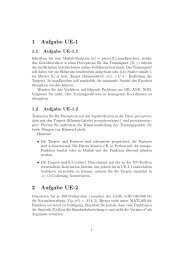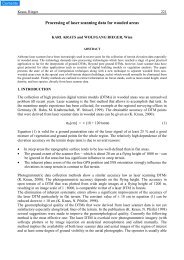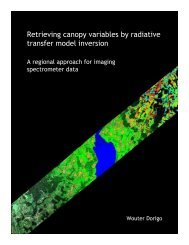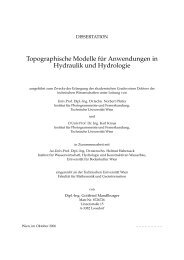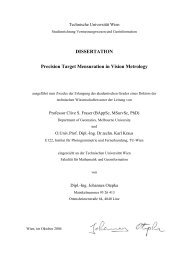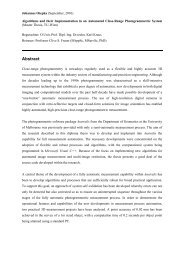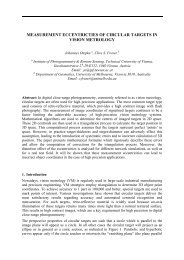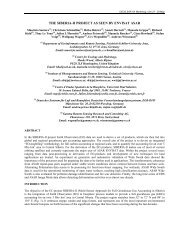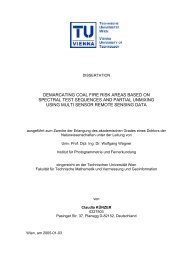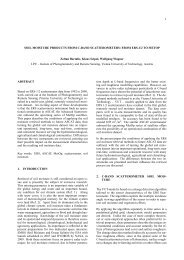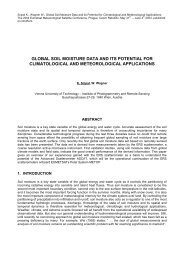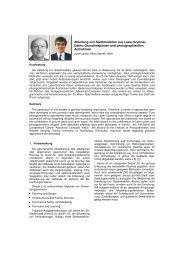Development and implementation of a Discrete Global Grid ... - ESA
Development and implementation of a Discrete Global Grid ... - ESA
Development and implementation of a Discrete Global Grid ... - ESA
You also want an ePaper? Increase the reach of your titles
YUMPU automatically turns print PDFs into web optimized ePapers that Google loves.
DEVELOPMENT AND IMPLEMENTATION OF A DISCRETE GLOBAL GRID SYSTEM<br />
FOR SOIL MOISTURE RETRIEVAL USING THE METOP ASCAT SCATTEROMETER<br />
Zoltan Bartalis (1) , Richard Kidd (1) , Klaus Scipal (1)<br />
(1) Institute <strong>of</strong> Photogrammetry <strong>and</strong> Remote Sensing, Vienna University <strong>of</strong> Technology,<br />
Gusshausstr. 27-29/E122, A-1040 Wien, Austria,<br />
zb@ipf.tuwien.ac.at, rk@ipf.tuwien.ac.at, ks@ipf.tuwien.ac.at<br />
ABSTRACT/RESUME<br />
Over the last years, the Institute <strong>of</strong> Photogrammetry<br />
<strong>and</strong> Remote Sensing (I.P.F., Vienna University <strong>of</strong><br />
Technology) has been putting in practice the retrieval<br />
<strong>of</strong> soil moisture from ERS scatterometer data. Anticipating<br />
the operational <strong>and</strong> partly near-real time creation<br />
<strong>of</strong> soil moisture products based on the existent ERS<br />
methods applied to the upcoming ASCAT scatterometer<br />
data, we evaluate the appropriateness <strong>of</strong> four c<strong>and</strong>idate<br />
discrete global grids systems (DGG) for processing<br />
soil moisture data based on the 25 km ASCAT<br />
data. The c<strong>and</strong>idate grids represent the current state <strong>of</strong><br />
the art both within I.P.F.’s operational processing environments<br />
<strong>and</strong> within the larger scientific community. A<br />
simple compliance matrix determines that the grid most<br />
suited for our purposes is our own in-house so-called<br />
QSCAT grid, a variant <strong>of</strong> a Sinusoidal <strong>Global</strong> <strong>Grid</strong>.<br />
Besides the increase <strong>of</strong> resolution, we implement improvements<br />
<strong>of</strong> the resampling procedures used to transfer<br />
scatterometer data from orbit geometry to the global<br />
grid.<br />
The present study was funded by the Numerical<br />
Weather Prediction Satellite Application Facility<br />
(NWP SAF, http://www.met<strong>of</strong>fice.com/research/<br />
interproj/nwpsaf).<br />
1. INTRODUCTION<br />
The Institute <strong>of</strong> Photogrammetry <strong>and</strong> Remote Sensing<br />
(I.P.F.) <strong>of</strong> the Vienna University <strong>of</strong> Technology<br />
(TU Wien) has been developing algorithms <strong>and</strong> s<strong>of</strong>tware<br />
for producing soil moisture data from ERS-1/2<br />
scatterometer data since 1994. The s<strong>of</strong>tware for processing<br />
the scatterometer data is called WARP (soil<br />
WAter Retrieval Package). The most distinct feature <strong>of</strong><br />
WARP is that all processing is done in the time domain.<br />
Since scatterometer data arrive in an image format,<br />
with satellite geometry, the data need to be reorganised<br />
from an image to a time series format in the<br />
first processing step. In order to organise backscatter<br />
time series, measurements must be spatially aggregated<br />
into sets <strong>of</strong> regions (so-called grid areas) that partition<br />
the surface <strong>of</strong> the Earth in an approximately regular<br />
manner. Such regions form a <strong>Discrete</strong> <strong>Global</strong> <strong>Grid</strong><br />
(DGG) or, if delivered with various resolution steps, a<br />
<strong>Discrete</strong> <strong>Global</strong> <strong>Grid</strong> System (DGGS). Each defined<br />
grid area is associated with time series <strong>of</strong> backscatter<br />
measurements <strong>and</strong> holds its own entry in the backscatter<br />
metadata database. As part <strong>of</strong> the continuing development<br />
<strong>of</strong> the WARP package this document focuses<br />
upon the assessment <strong>and</strong> recommendations for the<br />
improvement <strong>of</strong> the currently used DGG in order to<br />
accommodate 25 km resolution data from the ASCAT<br />
instrument onboard the upcoming MetOp satellite<br />
series. For this, four c<strong>and</strong>idate grids obtained by the<br />
three main grid generation techniques are compared<br />
<strong>and</strong> evaluated.<br />
2. STATEMENT OF REQUIREMENTS<br />
The design or selection <strong>of</strong> an appropriate DGG for<br />
I.P.F.’s soil moisture product depends on a number <strong>of</strong><br />
requirements <strong>and</strong> their specific implications:<br />
Coverage: The grid should be provided by a single<br />
solution covering all major l<strong>and</strong> masses <strong>of</strong> the Earth.<br />
Equal Area: The full information content <strong>of</strong> the input<br />
data should be maintained. This implies uniformly<br />
spaced isotropic equal area grid at (at least) twice instrument<br />
resolution from which the data is received.<br />
Coordinate system: Coordinate transformation <strong>and</strong><br />
data location errors should be minimised. The grid<br />
should be presented in the same coordinate system as<br />
the input satellite data.<br />
<strong>Grid</strong> Spacing: Interpolation errors due to regridding<br />
should be minimised. This requires uniform grid spacing.<br />
Data Access: The requirement for near real time product<br />
generation means that the grid design must allow<br />
effective h<strong>and</strong>ling <strong>and</strong> gridding <strong>of</strong> large scatterometer<br />
input datasets, with efficient methods for grid indexing<br />
<strong>and</strong> point location in order to effectively transfer data<br />
from orbital geometry to the grid system <strong>and</strong> vice<br />
versa.<br />
Resolution: The capability to sufficiently increase or<br />
decrease resolution <strong>of</strong> the grid, to resolve scales <strong>of</strong><br />
interest should be considered. This raises the question<br />
if a congruent grid should be employed.<br />
Resampling: It should be possible to resample the grid<br />
in a meaningful manner to any other grid. This will<br />
afford maximal possibly for product validation or comparison,<br />
either within house, or within the general scientific<br />
community.<br />
Proceedings <strong>of</strong> the 1st EPS/MetOp RAO Workshop, 15-17 May 2006, ESRIN, Frascati, Italy<br />
(<strong>ESA</strong> SP-618, August 2006)
Knowledge Transfer: Heritage, in terms <strong>of</strong> knowledge<br />
<strong>and</strong> technology, from I.P.F.’s experience in developing<br />
<strong>and</strong> working with adapted sinusoidal grids should be<br />
fully exploited.<br />
3. DISCRETE GLOBAL GRIDS OVERVIEW<br />
There are many different types <strong>of</strong> discrete global grids<br />
each with different properties <strong>and</strong> therefore different<br />
“best” uses, but as discussed in [1], global grids are<br />
generally obtained by one <strong>of</strong> three main techniques:<br />
Partitioning: The most commonly used regular DGGs;<br />
the globe is partitioned along the geographic latitudelongitude<br />
coordinate system. Its main advantage is that<br />
historically the geographic coordinate system is a well<br />
known <strong>and</strong> well used coordinate system <strong>and</strong> is the basis<br />
for a varied number <strong>of</strong> datasets <strong>and</strong> processing s<strong>of</strong>tware.<br />
The two dimensional map <strong>of</strong> the geographic<br />
projection is termed the Plate Carrée projection. <strong>Grid</strong>s<br />
based on square partitions are familiar <strong>and</strong> map effectively<br />
to common data structures <strong>and</strong> display devices.<br />
Raster data sets are <strong>of</strong>ten based upon cell regions with<br />
edges defined by arcs <strong>of</strong> equal angle increments <strong>of</strong><br />
latitude <strong>and</strong> longitude (e.g. 0.5°×0.5°, 2.5°×2.5°).<br />
Numerous adapted DGGs based upon the geographic<br />
latitude-longitude grid have been implemented to address<br />
some <strong>of</strong> the inherent limitations, such as strong<br />
distortions at high latitudes. One such adaptation is to<br />
decrease the number <strong>of</strong> cells with increasing latitude to<br />
achieve more consistent cell size.<br />
Tiling: With the application <strong>of</strong> more complex projection<br />
systems the partitioning technique evolved into a<br />
technique known as tiling. The globe, once in a specified<br />
projection, is tiled with a square lattice which<br />
forms a DGG. A map projection will either optimise<br />
equal area, true shape or true distance or will provide a<br />
compromise between them. For global remote sensing<br />
applications the most important characteristic <strong>of</strong> a map<br />
projection is that <strong>of</strong> equal area or equivalence. Therefore<br />
area preserving projections such as the cylindrical<br />
equal area projection are preferred.<br />
Subdivision: In this case, the globe is inscribed into a<br />
platonic solid whose faces are then subdivided into<br />
regular shapes, such as triangles, diamonds or hexagons.<br />
As noted by e.g. [2], there are only five so-called<br />
platonic solids which can be used for this. Although<br />
this method generates a DGG with uniform cell dimensions,<br />
the cell dimensions cannot be chosen freely but<br />
are determined by the particular geometrical division<br />
used. The generation <strong>of</strong> such DGGs is complex, as is<br />
the relationship between cell <strong>and</strong> geographic locations.<br />
Whilst tiling or partitioning may be implemented on an<br />
ellipsoid definition <strong>of</strong> the globe, most subdivision<br />
techniques limit themselves to the sphere due to increased<br />
complexity.<br />
4. CANDIDATE GRIDS<br />
In the following section four c<strong>and</strong>idate DGG’s are<br />
presented. The first two are current operational grids<br />
used within I.P.F. The other two grids were selected as<br />
one represents the most commonly used DGG for h<strong>and</strong>ling<br />
<strong>of</strong> earth observation data (the EASE grid), <strong>and</strong><br />
the final DGG is selected as this is the pro-posed DGG<br />
to be used for the future Soil Moisture <strong>and</strong> Ocean Salinity<br />
(SMOS) mission.<br />
4.1. The WARP4 <strong>Grid</strong><br />
The discrete global grid used in WARP version 4.0 for<br />
ERS data aggregation is an adapted version <strong>of</strong> a sinusoidal<br />
global grid applied on the sphere [3]. The grid is<br />
generated in two steps.<br />
In the first step, a series <strong>of</strong> latitude small circles are<br />
created, equally spaced with a central angle <strong>of</strong> 0.25º in<br />
the south-north direction along any meridian, starting<br />
with the south pole (Fig. 1). An Earth radius <strong>of</strong><br />
6370 km is assumed, yielding a constant spacing between<br />
the latitude circles <strong>of</strong><br />
d = 6370 ⋅ 0.25 ⋅π<br />
/180 ≈ 27.79 km , (1)<br />
λ<br />
suitable for the processing <strong>of</strong> 50 km resolution ERS<br />
data [4].<br />
In the second step, the Equator is also divided into<br />
0.25º longitude intervals, giving 4·360=1440 divisions.<br />
Each <strong>of</strong> the latitude circles created above is then subsequently<br />
divided into 1440·cos(λ) divisions, where λ is<br />
the latitude <strong>of</strong> the circle. This ensures the same<br />
27.8 km spacing in the west-east direction as well,<br />
subject to slight variations due to decimal rounding.<br />
The number <strong>of</strong> grid points on each latitude circle decreases<br />
thus with increasing latitude <strong>and</strong> thus addresses<br />
high latitude distortion problems noted in [2]. The<br />
WARP4 grid covers the l<strong>and</strong> surface <strong>of</strong> the Earth with<br />
more than 180000 single grid areas.<br />
4.2. The QSCAT <strong>Grid</strong><br />
The so-called QSCAT grid is very similar to the<br />
WARP4 grid described above <strong>and</strong> was implemented at<br />
I.P.F. for storing <strong>and</strong> processing data from the Sea-<br />
Winds scatterometer onboard the QuikSCAT platform<br />
[5]. Unlike the WARP4 grid, it uses the Geodetic Reference<br />
System 1980 (GRS 80) ellipsoid rather than the<br />
sphere. Instead <strong>of</strong> using equal central angles between<br />
the latitude circles, it uses an equal arc length <strong>of</strong> 10 km,<br />
calculated as a local spherical (Gaussian) radius [6].<br />
The longitudinal arc distances between grid points on<br />
the same latitude circle are also set to 10 km, ensuring<br />
consistent arc distances in the west-east direction at the<br />
price <strong>of</strong> a discontinuity at the 180º meridian. Since this<br />
region lies mostly in the Pacific Ocean, the discontinu-
ity does not influence retrieval <strong>of</strong> l<strong>and</strong> parameters,<br />
subject to a small area in the Russian far east.<br />
4.3. The EASE <strong>Grid</strong><br />
The Equal-Area Scalable Earth <strong>Grid</strong> (EASE-<strong>Grid</strong>) was<br />
created by the National Snow <strong>and</strong> Ice Data Center<br />
(NSIDC), University <strong>of</strong> Colorado <strong>and</strong> the University <strong>of</strong><br />
Michigan Radiation Laboratory (RADLAB). It was<br />
designed to suit the specific needs <strong>of</strong> SSM/I (Special<br />
Sensor Microwave Imager) satellite data, but with a<br />
potential for general application to any global scale<br />
data set. In the EASE-grid, data can be expressed as<br />
digital arrays <strong>of</strong> varying grid resolutions, defined in<br />
relation to one <strong>of</strong> three possible projections, northern,<br />
southern (both in Lambert’s Azimuthal Equal Area<br />
projection) <strong>and</strong> global (in the Cylindrical Equal Area<br />
projection). The grid is defined as a rectangular matrix<br />
on each <strong>of</strong> the projections, where each column <strong>and</strong> row<br />
can be easily matched to its latitude-longitude coordinate.<br />
Row <strong>and</strong> column positions are computed differently<br />
for each <strong>of</strong> the possible projections, thus marking<br />
EASE as a non-global Earth grid. Another disadvantage<br />
is its lack <strong>of</strong> uniform adjacency (due to the square<br />
shape <strong>of</strong> its cells) <strong>and</strong> the distortions above mid latitudes<br />
in the global projection [7]. Its main advantage is<br />
the fact that square cells display very effectively on<br />
digital output devices based on square lattices <strong>of</strong> pixels.<br />
4.4. The SMOS <strong>Grid</strong><br />
The proposed grid recommended for <strong>implementation</strong><br />
for SMOS data was selected to fulfil two main requirements.<br />
Firstly, it should maintain full information<br />
content <strong>of</strong> the measured SMOS samples corresponding<br />
to a maximum instrument resolution <strong>of</strong> 30 km. This<br />
requirement translated to the necessity to select a uniformly<br />
spaced global <strong>and</strong> isotropic grid at twice the<br />
instrument resolution <strong>of</strong> 15km. Secondly, interpolation<br />
error due to regridding to arbitrary user defined grids<br />
should be minimised. This can be achieved by having a<br />
uniform intercellular spacing. After a comparison <strong>of</strong> a<br />
number <strong>of</strong> DGG’s, the Icosahedron Snyder Equal Area<br />
(ISEA) Aperture 4 Hexagonal (ISEA4H) DGGS was<br />
selected as the prime c<strong>and</strong>idate [1]. The process <strong>of</strong><br />
a. b.<br />
6. THE PROPOSED WARP5 GRID<br />
Based on Tab. 1 we conclude that the most suitable<br />
c<strong>and</strong>idate grid, with the highest score, is the QSCAT<br />
one. We therefore define the WARP5 grid as the<br />
QSCAT grid, with the difference <strong>of</strong> using the GEM6<br />
ellipsoid <strong>and</strong> a grid spacing arc length <strong>of</strong> a = 12.5 km.<br />
The grid construction procedure described in Section<br />
4.2 applied for WARP5 is illustrated in Fig. 1. The<br />
resulting grid configuration for three different areas is<br />
shown in detail in Fig. 2, including the discontinuity at<br />
the 180° meridian. For more accuracy, the radius <strong>of</strong> the<br />
Earth used for calculating the latitude λ j <strong>of</strong> the latitude<br />
small circles should be approximated with the radius <strong>of</strong><br />
curvature <strong>of</strong> the meridian, given in e.g. [6]. The discrete<br />
longitudes along the latitude circles should be<br />
calculated using the same Gaussian Earth radius apa<br />
=<br />
12.5 km<br />
l j<br />
a = 12.5 km<br />
Figure 1. Constructing the WARP5 grid: a) equally<br />
spaced latitude small circles; b) grid points created at<br />
discrete longitudes on each latitude circle.<br />
creating the grid involves subdividing the 20 equilateral<br />
faces <strong>of</strong> the regular icosahedron into more triangles,<br />
yielding 20 hexagons <strong>and</strong> 12 pentagons on the<br />
surface <strong>of</strong> the sphere (the so-called resolution 1 grid).<br />
Higher resolution grids (in discrete steps) are formed<br />
by further tesselating the obtained shapes. Constructing<br />
the higher-resolution ISEA grids requires usage <strong>of</strong><br />
complex forward <strong>and</strong> inverse projection formulas to<br />
resolve cartesian to geographic coordinates as well as a<br />
relatively advanced indexing system for the created<br />
cells.<br />
Table 1. Comparing the c<strong>and</strong>idate grids.<br />
Requirement WARP QSCAT EASE SMOS<br />
Coverage <br />
Equal Area <br />
Geodetic <br />
System<br />
<strong>Grid</strong> Spacing <br />
Data Access <br />
Ease <strong>of</strong> im-<br />
<br />
plementation<br />
Score 4 5 3 3<br />
5. ASSESMENT OF CANDIDATE GRIDS<br />
As noted in [2], there is no single DGG that can provide<br />
an optimum solution for all applications, <strong>and</strong> so in<br />
the DGG assessment, as with any requirement driven<br />
solution, the requirement criteria do have an order <strong>of</strong><br />
importance, <strong>and</strong> therefore a subjective weighting is<br />
applied. In relation to the grid for the ASCAT soil<br />
moisture products (hereafter termed the WARP5 grid)<br />
is it critical that the requirements concerning efficient<br />
data access, geodetic coordinate system, <strong>and</strong> ease <strong>of</strong><br />
<strong>implementation</strong> are fulfilled while keeping an as uniform<br />
spacing <strong>of</strong> the grid cells as possible. The simple<br />
compliance matrix in Tab. 1 presents a summary <strong>of</strong> the<br />
assessment <strong>of</strong> the c<strong>and</strong>idate grids.
0.50<br />
-140<br />
-160<br />
-180<br />
160<br />
140<br />
68<br />
-120<br />
120<br />
-0.50 0<br />
0.50<br />
-100<br />
-80<br />
90<br />
100<br />
80<br />
178 179 67.50 180 -179<br />
-60<br />
60<br />
-0.50<br />
-40<br />
-20<br />
89.50<br />
0<br />
20<br />
40<br />
67<br />
a)<br />
b)<br />
c)<br />
Figure 2. Details <strong>of</strong> three areas <strong>of</strong> the proposed grid: a) at its origin; b) at the North Pole; c) at the 180° meridian.<br />
distance to nearest grid point (km)<br />
12.500<br />
12.490<br />
12.480<br />
12.470<br />
12.460<br />
12.450<br />
0 10 20 30 40 50 60 70 80 90<br />
latitude<br />
Figure 3. Nearest grid point distance <strong>and</strong> spanned<br />
interlongitudinal angle.<br />
proximation as for the QSCAT grid [6]. As a measure<br />
<strong>of</strong> the grid spacing (where both the WARP4 <strong>and</strong><br />
QSCAT grids have been awarded negative marks in<br />
Tab. 1), Fig. 3 shows the arc lengths between each grid<br />
point <strong>and</strong> its closest neighbouring grid point (points<br />
close to the discontinuity at the 180° meridian excluded).<br />
It can be seen that that the arc length varies<br />
reasonably from 12.455 km at the Equator to the nominal<br />
12.500 km near to the poles. The diagram also<br />
shows the increasing interlongitudinal distance between<br />
grid points on different latitude circles expressed<br />
as the longitudinal angle spanned by two neighbouring<br />
points.<br />
7. WARP5 GRID POINT INDEXING<br />
Due to the large number <strong>of</strong> grid points (3264399 points<br />
globally, distributed on 1601 latitude circles), the<br />
WARP5 grid configuration would be practically incomplete<br />
without fast <strong>and</strong> effective procedures for grid<br />
point indexing <strong>and</strong> neighbourhood search. In our proposed<br />
<strong>implementation</strong> we allow for regional processing<br />
by organising the grid points into 20°×20° cells. We<br />
also only consider grid points covering significant l<strong>and</strong><br />
areas, using the l<strong>and</strong> flags included in the scatterometer<br />
1.8<br />
1.5<br />
1.2<br />
0.9<br />
0.6<br />
0.3<br />
interlongitudinal distance (degrees)<br />
data or a static external l<strong>and</strong> mask. We save all grid<br />
point metadata (latitude, longitude, cell number, etc.) in<br />
lookup tables in the form <strong>of</strong> arrays. Using the array<br />
indices for the naming <strong>of</strong> the files holding the actual<br />
backscatter time series for each grid point is an effective<br />
way <strong>of</strong> accessing the data. For the quick resampling<br />
<strong>of</strong> incoming data from orbit to grid geometry we<br />
use neighbourhood search routines based on successive<br />
geographic coordinate queries: for example, for an<br />
incoming data frame <strong>of</strong> ASCAT measurements one<br />
could first find a subset <strong>of</strong> grid points covering entirely<br />
the extent <strong>of</strong> the data frame, followed by finding the<br />
neighbourhoods <strong>of</strong> the individual frame data nodes<br />
within the subset.<br />
8. REFERENCES<br />
1. Suess, M., et al., Processing <strong>of</strong> SMOS level 1c data<br />
onto a discrete global grid. International Geoscience<br />
<strong>and</strong> Remote Sensing Symposium<br />
(IGARSS), Vol. 3, 1914–1917, 2004.<br />
2. Sahr, K., et al., Geodesic discrete global grid systems.<br />
Cartography <strong>and</strong> Geographic Information<br />
Science, Vol. 30(2), 121–134, 2003.<br />
3. Wagner, W., Soil Moisture Retrieval from ERS<br />
Scatterometer Data, dissertation, Vienna University<br />
<strong>of</strong> Technology, Vienna, Austria, 1998.<br />
4. Scipal, K., <strong>Global</strong> Soil Moisture Retrieval from ERS<br />
Scatterometer Data, dissertation, Institute <strong>of</strong> Photogrammetry<br />
<strong>and</strong> Remote Sensing, Vienna University<br />
<strong>of</strong> Technology, Vienna, Austria, 2002.<br />
5. Kidd, R. A., et al., The development <strong>of</strong> a processing<br />
environment for time-series analysis <strong>of</strong> SeaWinds<br />
scatterometer data. International Geoscience <strong>and</strong><br />
Remote Sensing Symposium (IGARSS), Vol. 6,<br />
4110–4112, 2003.<br />
6. Torge, W., Geodesy, 3rd Edition, , Chapter 4.1: The<br />
Rotational Ellipsoid. de Gruyter, 2001, ISBN: 3-<br />
11-017072-8.<br />
7. Brodzik, M., J., EASE-<strong>Grid</strong>: A Versatile Set <strong>of</strong><br />
Equal-Area Projections <strong>and</strong> <strong>Grid</strong>s, http://nsidc.org/<br />
data/ease/ease_grid.html, web resource accessed<br />
on 1 Aug. 2005.



